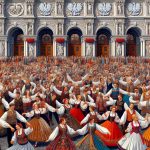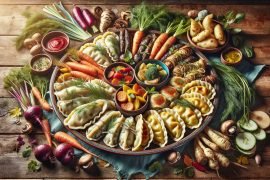
The Gorals of Poland represent a unique cultural group with deep roots in the mountain regions. Their culture is a blend of age-old traditions, music, and customs that have stood the test of time despite modern changes. Living closely with nature and holding onto the traditions of their ancestors, the Gorals have a distinct way of life.
Their traditional music is unique, and their folk costumes carry special meanings, each telling stories of survival and community spirit. When we dive into these cultural aspects, it’s interesting to think about how these traditions fit into our modern, globalized world. It’s impressive how these communities keep their identity alive while everything around them continues to evolve.
The Gorals: Mountain Guardians
In Poland’s southern highlands, a group known as the Gorals lives. They are famous for protecting the mountains and have a rich cultural heritage. The Gorals have adapted well to the difficult mountain conditions, developing a lifestyle that is closely connected to nature. Their traditions include wearing detailed folk costumes and building wooden houses that are both beautiful and practical. These practices show how the Gorals have found ways to live in harmony with their environment.
The Gorals’ community is tight-knit, with a strong emphasis on respecting the wisdom passed down from their ancestors. This deep respect helps them maintain a strong bond with the mountains. By keeping their traditions alive, the Gorals provide important insights into how people can live in balance with nature.
For example, the construction of their wooden houses is not only a testament to the Gorals’ craftsmanship but also to their understanding of sustainable living. These homes, made from local materials, blend seamlessly into the surrounding landscape, showcasing an early form of eco-friendly architecture.
Traditional Highlander Music
Highlander music from Poland’s southern highlands is more than just tunes; it’s a window into the life and soul of the Gorals, the local people. This music, rich with history, mirrors the landscapes and the lives led in this rugged region. It’s unique because it uses instruments like the fiddle, bagpipes, and a special drum called the Morskie Oko. These aren’t just for show. Each one adds a layer to the music, making it a powerful tool to share stories about everyday life, love, and the hard work of living in the mountains.
What makes Highlander music stand out is how it connects with nature. Its rhythms and melodies match the changing seasons, the rivers’ flow, and even how animals move. It’s like the music is a bridge between the Gorals and the natural world around them. When people perform this music, it’s not just for fun. It’s a way to keep their culture alive, passing on traditions and stories that define who they are.
Let’s not forget the singing. It’s heartfelt and often improvised, showing a wide range of emotions. This style of singing, combined with the music, creates a vivid picture of Goral life that resonates with anyone who listens.
In essence, Highlander music does more than entertain. It preserves the heritage of the Gorals, showcasing their deep connection to their environment. It’s a living tradition that continues to evolve, keeping the spirit of the southern highlands of Poland alive and vibrant.
Folk Attire and Symbols
The folk attire and symbols of the Highlanders in Poland are more than just eye-catching. They are a key part of how this community expresses its unique identity. Each element, from the detailed “parzenica” patterns on trousers to the decorative woolen “kierpce” shoes, tells a story. These stories include where a person comes from, whether they are married, and what family they belong to. It’s fascinating how clothing and accessories can provide such deep insights into a person’s life and background.
For example, the “parzenica” patterns aren’t just random designs. They are deeply symbolic, often passed down through generations. Wearing them is a way of honoring one’s ancestors and keeping their memory alive. Similarly, the “kierpce” shoes are not just practical footwear for rugged mountain terrain; they are a nod to traditional craftsmanship and the Highlander’s close relationship with nature.
The choice of colors, materials, and designs in Highlander attire isn’t random. It’s a deliberate effort to maintain a connection with their past while navigating the present. This balance between tradition and modernity is what keeps the Highlander culture vibrant and relevant today.
Moreover, the attire serves as a walking history book, offering a glimpse into the Highlanders’ rich cultural heritage. It’s a heritage that includes not just personal and family histories but also the broader history of the region and its people. By wearing these garments and symbols, Highlanders weave their personal stories into the larger tapestry of their community’s history.
In a world where fast fashion often overlooks cultural significance, the Highlanders’ approach to clothing is a reminder of the value of tradition and craftsmanship. It’s an invitation to explore the stories behind the clothes we wear and to appreciate the ways in which they can connect us to our roots.
Celebrations and Festivities
In Poland’s Highlands, people celebrate their culture with lively events that highlight important times and changes in their lives. These celebrations are not just fun; they show the strong cultural identity of the Highlanders. They mix old pagan traditions with Christian beliefs, showing a rich cultural heritage. For example, the Góralski Ślub, or Highlander wedding, is a big event. It has many special customs, like dressing up the bride and groom in traditional ways and having a parade through the village. This gets everyone involved and celebrates the couple’s new journey together.
The changing seasons and religious events also shape these festivities. For instance, the Dżdżownica marks the start of spring. It’s a day filled with joy as it represents new beginnings. Another event is when people lead their sheep to the mountain pastures. This is not just about farming; it’s a tradition that shows the deep bond between the Highlanders and their land. These events are more than just parties; they’re a way for the community to come together and remember their roots.
What’s really interesting is how these traditions keep the community strong. For example, the wedding procession is not just a walk; it’s a way for the whole village to show support for the couple. And when the sheep are taken to the pastures, it’s a reminder of the importance of nature in Highlander life. These traditions are not just for the Highlanders; they attract visitors who want to experience this unique culture. So, if you’re ever in Poland, trying to join in these festivities could be a great way to see the rich culture and tradition of the Highlanders.
Cuisine of the Highlands
The Highland region’s cuisine reflects its rich cultural background, mixing historical practices with local ingredients to create unique tastes. This culinary style stems from the Highlanders’ farming lifestyle, with a focus on sheep farming and dairy products. One example of this is ‘oscypek,’ a smoked cheese made from sheep’s milk. This cheese showcases the area’s natural resources and the skill of local artisans. Another dish, ‘kwaśnica’ soup, made with sauerkraut and meat, shows how the community has adapted its food to the challenging mountain climate. These recipes are more than just food; they’re a living history, telling the story of the Highlanders’ deep connection to their land.
In simple terms, the food from the Highlands does more than fill you up. It carries the essence of the region’s history, environment, and the people’s relationship with the land. For instance, when you taste ‘oscypek,’ you’re not just enjoying a piece of cheese; you’re experiencing a piece of Highland culture. This cheese, with its rich, smoky flavor, is a direct result of the traditional sheep farming in the area. Similarly, ‘kwaśnica’ soup doesn’t just offer warmth on a cold day; it’s a survival strategy turned into a culinary tradition, making use of available ingredients in a challenging terrain.
Understanding this cuisine gives you insight into the Highlanders’ world. Their food tells stories of adapting to the environment, of community, and of preserving traditions through generations. It’s a vivid example of how culture, history, and geography can shape a region’s food. So, if you’re looking to explore the Highlands, don’t just visit the landscapes. Dive into the local cuisine to truly understand the heart of this unique region.
Conclusion
The Gorals, or Highlanders, in Poland have a fascinating culture and traditions that show their strong spirit, creativity, and sense of community. They express themselves through music, traditional clothes, festivals, and food, keeping their rich history alive.
Looking into the way of life of the Gorals gives us a deeper appreciation of the variety of cultures around the world and teaches us about the value of keeping cultural identities alive. It’s like getting a glimpse into the heart of what makes us human and celebrating the different colors we all bring to the world’s canvas.






Comments are closed.